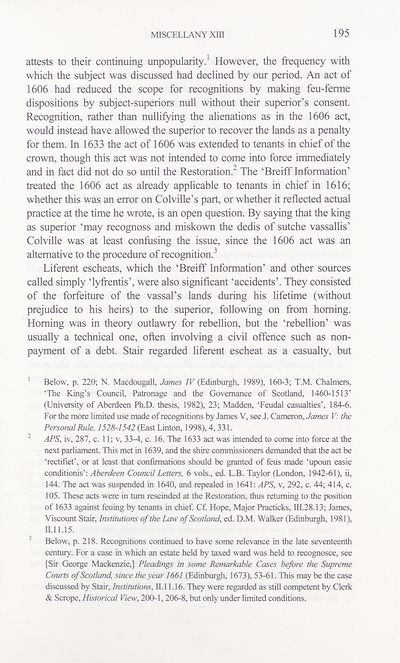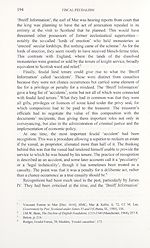Series 5 > Miscellany [of the Scottish History Society] XIII
(210) Page 195
Download files
Complete book:
Individual page:
Thumbnail gallery: Grid view | List view

MISCELLANY XIII
195
attests to their continuing unpopularity.1 However, the frequency with
which the subject was discussed had declined by our period. An act of
1606 had reduced the scope for recognitions by making feu-ferme
dispositions by subject-superiors null without their superior’s consent.
Recognition, rather than nullifying the alienations as in the 1606 act,
would instead have allowed the superior to recover the lands as a penalty
for them. In 1633 the act of 1606 was extended to tenants in chief of the
crown, though this act was not intended to come into force immediately
and in fact did not do so until the Restoration.2 The ‘Breifflnformation’
treated the 1606 act as already applicable to tenants in chief in 1616;
whether this was an error on Colville’s part, or whether it reflected actual
practice at the time he wrote, is an open question. By saying that the king
as superior ‘may recognoss and miskown the dedis of sutche vassallis’
Colville was at least confusing the issue, since the 1606 act was an
alternative to the procedure of recognition.3
Liferent escheats, which the ‘Breiff Information’ and other sources
called simply ‘lyffentis’, were also significant ‘accidents’. They consisted
of the forfeiture of the vassal’s lands during his lifetime (without
prejudice to his heirs) to the superior, following on from homing.
Homing was in theory outlawry for rebellion, but the ‘rebellion’ was
usually a technical one, often involving a civil offence such as non¬
payment of a debt. Stair regarded liferent escheat as a casualty, but
1 Below, p. 220; N. Macdougall, James IV (Edinburgh, 1989), 160-3; T.M. Chalmers,
‘The King’s Council, Patronage and the Governance of Scotland, 1460-1513’
(University of Aberdeen Ph.D. thesis, 1982), 23; Madden, ‘Feudal casualties’, 184-6.
For the more limited use made of recognitions by James V, see J. Cameron, James V: the
Personal Rule, 1528-1542 (East Linton, 1998), 4,331.
2 APS, iv, 287, c. 11; v, 33-4, c. 16. The 1633 act was intended to come into force at the
next parliament. This met in 1639, and the shire commissioners demanded that the act be
‘rectifiet’, or at least that confirmations should be granted of feus made ‘upoun easie
conditionis’: Aberdeen Council Letters, 6 vols., ed. L.B. Taylor (London, 1942-61), ii,
144. The act was suspended in 1640, and repealed in 1641: APS, v, 292, c. 44; 414, c.
105. These acts were in turn rescinded at the Restoration, thus returning to the position
of 1633 against feuing by tenants in chief. Cf. Hope, Major Practicks, III.28.13; James,
Viscount Stair, Institutions of the Law of Scotland, ed. D.M. Walker (Edinburgh, 1981),
11.11.15.
3 Below, p. 218. Recognitions continued to have some relevance in the late seventeenth
century. For a case in which an estate held by taxed ward was held to recognosce, see
[Sir George Mackenzie,] Pleadings in some Remarkable Cases before the Supreme
Courts of Scotland, since the year 1661 (Edinburgh, 1673), 53-61. This may be the case
discussed by Stair, Institutions, II. 11.16. They were regarded as still competent by Clerk
& Scrape, Historical View, 200-1,206-8, but only under limited conditions.
195
attests to their continuing unpopularity.1 However, the frequency with
which the subject was discussed had declined by our period. An act of
1606 had reduced the scope for recognitions by making feu-ferme
dispositions by subject-superiors null without their superior’s consent.
Recognition, rather than nullifying the alienations as in the 1606 act,
would instead have allowed the superior to recover the lands as a penalty
for them. In 1633 the act of 1606 was extended to tenants in chief of the
crown, though this act was not intended to come into force immediately
and in fact did not do so until the Restoration.2 The ‘Breifflnformation’
treated the 1606 act as already applicable to tenants in chief in 1616;
whether this was an error on Colville’s part, or whether it reflected actual
practice at the time he wrote, is an open question. By saying that the king
as superior ‘may recognoss and miskown the dedis of sutche vassallis’
Colville was at least confusing the issue, since the 1606 act was an
alternative to the procedure of recognition.3
Liferent escheats, which the ‘Breiff Information’ and other sources
called simply ‘lyffentis’, were also significant ‘accidents’. They consisted
of the forfeiture of the vassal’s lands during his lifetime (without
prejudice to his heirs) to the superior, following on from homing.
Homing was in theory outlawry for rebellion, but the ‘rebellion’ was
usually a technical one, often involving a civil offence such as non¬
payment of a debt. Stair regarded liferent escheat as a casualty, but
1 Below, p. 220; N. Macdougall, James IV (Edinburgh, 1989), 160-3; T.M. Chalmers,
‘The King’s Council, Patronage and the Governance of Scotland, 1460-1513’
(University of Aberdeen Ph.D. thesis, 1982), 23; Madden, ‘Feudal casualties’, 184-6.
For the more limited use made of recognitions by James V, see J. Cameron, James V: the
Personal Rule, 1528-1542 (East Linton, 1998), 4,331.
2 APS, iv, 287, c. 11; v, 33-4, c. 16. The 1633 act was intended to come into force at the
next parliament. This met in 1639, and the shire commissioners demanded that the act be
‘rectifiet’, or at least that confirmations should be granted of feus made ‘upoun easie
conditionis’: Aberdeen Council Letters, 6 vols., ed. L.B. Taylor (London, 1942-61), ii,
144. The act was suspended in 1640, and repealed in 1641: APS, v, 292, c. 44; 414, c.
105. These acts were in turn rescinded at the Restoration, thus returning to the position
of 1633 against feuing by tenants in chief. Cf. Hope, Major Practicks, III.28.13; James,
Viscount Stair, Institutions of the Law of Scotland, ed. D.M. Walker (Edinburgh, 1981),
11.11.15.
3 Below, p. 218. Recognitions continued to have some relevance in the late seventeenth
century. For a case in which an estate held by taxed ward was held to recognosce, see
[Sir George Mackenzie,] Pleadings in some Remarkable Cases before the Supreme
Courts of Scotland, since the year 1661 (Edinburgh, 1673), 53-61. This may be the case
discussed by Stair, Institutions, II. 11.16. They were regarded as still competent by Clerk
& Scrape, Historical View, 200-1,206-8, but only under limited conditions.
Set display mode to:
![]() Universal Viewer |
Universal Viewer | ![]() Mirador |
Large image | Transcription
Mirador |
Large image | Transcription
Images and transcriptions on this page, including medium image downloads, may be used under the Creative Commons Attribution 4.0 International Licence unless otherwise stated. ![]()
| Scottish History Society volumes > Series 5 > Miscellany [of the Scottish History Society] XIII > (210) Page 195 |
|---|
| Permanent URL | https://digital.nls.uk/127316049 |
|---|
| Description | Over 180 volumes, published by the Scottish History Society, containing original sources on Scotland's history and people. With a wide range of subjects, the books collectively cover all periods from the 12th to 20th centuries, and reflect changing trends in Scottish history. Sources are accompanied by scholarly interpretation, references and bibliographies. Volumes are usually published annually, and more digitised volumes will be added as they become available. |
|---|


